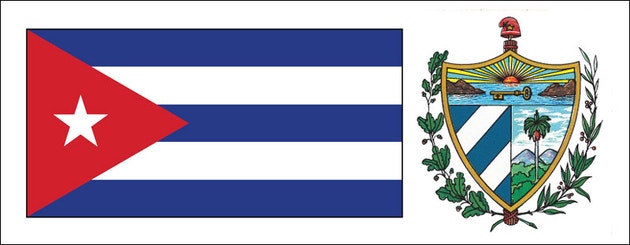
Citation (1)
An audio and video collection for classical, opera, jazz, world, popular music, and American music. Also includes theatre, dance, and film resources.
An encyclopedia about music all over the world.

Capital: Havana
Official language: Spanish
Location: The Republic of Cuba is an archipelago of two main islands—Cuba and the Isla de la Juventud (Isle of Youth), formerly the Isla de Pinos (Isle of Pines)—and about 1,600 keys and islets. It lies in the Caribbean Sea, 145 km (90 miles) south of Florida, USA
National anthem: "La Bayamesa" ("The Bayamo Song")
Area: 109,884 sq km (42,426 sq miles)
Current Population: 11.2m
Climate: Warm, mild weather all year round, with a rainy season from May through October. Hurricanes often strike the island. Hurricane season lasts from June to November.
Money: Cuban Peso
Main Religion: Roman Catholic
Citations: Location, Climate, Language, Religion, Flag, Capital (Cuba), in Europa World online. London, Routledge. University of Tennessee, Knoxville. Retrieved 07 May 2021 from http://www.europaworld.com/entry/cu.is.2
Amerindian:
The first known inhabitants of Cuba were the Siboney and Arawak groups living on the island at the time of the Spanish conquest. The little that is known of their musical practices has been taken from the accounts of travelers such... Instruments employed by native groups included the mayohuacán, a hollowed-out log slit-drum similar to the Aztec teponaztle; wooden and conch-shell trumpets, the latter known as guamos or cobos; flutes; and wooden rattles similar to maracas. One of the most important forms of Siboney expression was the areíto, a communal religious event involving music, dance, ritual tobacco smoking and the consumption of alcoholic beverages. Responsorial song, a crucial element in the ceremony, was led by a tequina or musical specialist chosen by the tribe.
Iberian-derived:
These musical traditions have existed in Cuba since the earliest days of the conquest...the punto and décima are most closely associated with such heritage. The punto and décima are primarily song and string instrument traditions. They typically employ the laúd, tres and bandurria (variants of Spanish instruments developed in Cuba) as well as the guitar and maracas or other hand-held percussion. Strictly speaking, punto is a term used to describe instrumental music that usually accompanies song. Décima, by contrast, refers to the poetry most commonly associated with música guajira. . The Spanish-derived romance or lyric ballad also exists in Cuba, as do other Iberian genres.
Afro-Cuban:
Adopting the terminology of author Miguel Barnet, the music and dance of Regla de Ocha or Santería the santería ceremony can be regarded as the ‘fuente viva’ (living source) of much of Cuba’s cultural inspiration... it has been of fundamental importance to the development of most Cuban popular music and to the strength of African cultural retentions generally. Various types of music are associated with Afro-Cuban religions. These include formal performance events closed to non-initiates in which batá drumming and singing tend to predominate, as well as more open celebrations in which the batás or an ekón (bell) and one or more unconsecrated conga drums are more typically used, sometimes in conjunction with chéqueres (dried gourds shaken within a net of beads; fig.1a) or even violins.
Citation (3)
Cuban violinist and composer . Pierre gave his birthdate as 31 December 1837, which might suggest that he misrepresented his age on entering the Paris Conservatoire, where he studied the violin with Alard, winning a premier prix in 1856. In 1857–8 he was first violinist in a quintet and also gave concerts, but then left Paris to return to Cuba, where he gave concerts with Gottschalk. n 1866 he became a member of the Société des Concerts du Conservatoire; among his students were Enescu and Thibaud. He toured Europe, and from the early 1870s performed frequently with his wife, also a brilliant violinist. In 1874 or 1875 he went to the USA and then, after a brief visit to Paris at the end of 1876, to South America, where he toured widely, eventually becoming court violinist to the emperor Dom Pedro II of Brazil; with Napoleão dos Santos, he founded the Sociedade de Conciertos Clásicos there. His few compositions, most of them highly influenced by European models such as Wieniawski and Vieuxtemps, include a violin concerto, string quartet, a Bolero for violin and orchestra, Variaciones for harpsichord and orchestra, six concert studies for violin and several pieces for violin and piano, including La bella cubana, a kind of Cuban national air based on the rhythms of the old Haitian guaracha and the Dominican merengue.
Citation: Vega, A. (2001). White Lafitte, José. Grove Music Online. Retrieved 10 May. 2021
(1): "Cuba" by "Augusto Rovere"
(2): Map of Cuba. Digital Image. U.S. Department of State. Web. 7 Jun 2022. https://www.europaworld.com/country/Cuba?id=cu.
(3): Béhague, G., & Moore, R. (2001). Cuba, Republic of. Grove Music Online. Retrieved 10 May. 2021